In the shadow of Newark and New York airports, it’s easy to overlook the rich aviation history in New Jersey’s northwest corner. Way before Silicon Valley and the dawn of the computer age, guys in basements and industrial labs in the Skylands worked on the hot tech of the day— flight. By the middle of the last century, they’d helped usher in both modern aviation and the space age. Theirs weren’t famous names like Hewlett, Packer, Jobs, and Gates. Still, these scientists and engineers broke ground that changed the world. Located in and around early Skylands airports, they helped move airplanes from mainly experimental and military enterprises into the heart of American commerce and lives.
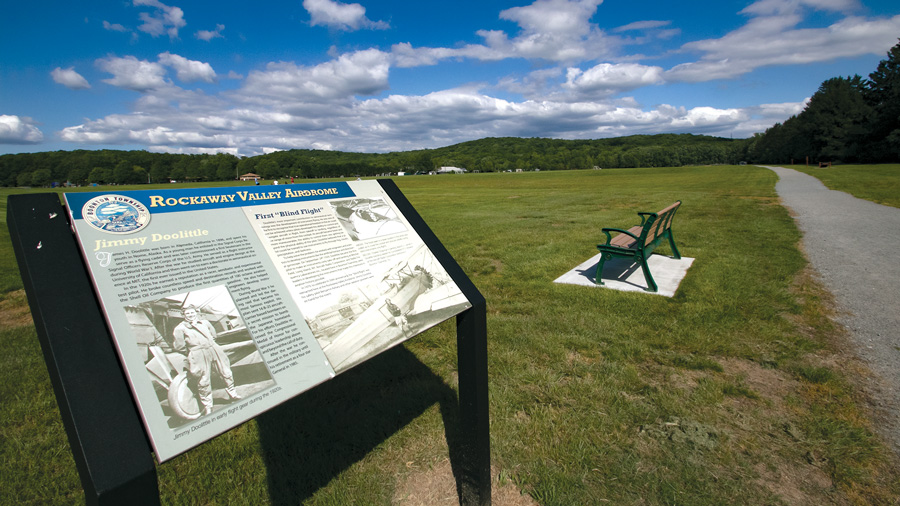
Make a loop this summer, visiting area airports and discover not only that science and history but also the thrill of flight — from the air if you dare, from the ground if you don’t. Walk a self-guided aviation history trail in Boonton Township, hitch a scenic ride on a glider in Blairstown, take an airport tour at Morristown, check skydiving off your bucket list, or relax with a beer, fish tacos and live music by the airstrip while watching takeoff and landing action in Lincoln Park. Every airport offers an adventure and tells a story. “It’s such a joy being up in the air,” says Linda Scully, owner of Aero Safety Training, a flight school operating at Lincoln Park Airport who’s been introducing novices to flying for more than twenty years. “The sky’s the limit.”
Testing whether the sky was in fact the limit challenged curious minds down through history, with kites, balloons, dirigibles, gliders and other man-made contraptions sent aloft for centuries with mixed success. Even the most dogged experimenters struggled to solve stubborn problems: how to steer airborne devices in a controlled way; keep them up for more than a few seconds; prevent them from breaking up mid-air and protect pilots from crashing. Others claimed to, and may in fact have been first, but the Wright brothers were credited with making the first “sustained” flight in 1903 in Kitty Hawk, North Carolina.
After World War I, with aviation unregulated, a sort of Wild West atmosphere prevailed with “barnstormers” coming to towns, offering rides and performing stunts mid-air on private planes. Things calmed down after the government got into the act in 1925, laying down some ground rules through regulation.
All the while, the hills and valleys of northwest New Jersey served as an incubator for the development of key technologies that kept moving aviation forward, paving the way for air mail, instrument-only navigation, and forays into space.
• Breakthroughs engineered in Boonton Township led to the first “blind flight in 1929, where a pilot successfully navigated his aircraft without looking at the ground.
• The country’s first commercial rocket company, Reaction Motors, which made its home in Pompton Plains, then moved to Denville, developed rocket engines, including the one whose 6,000 pounds of thrust powered Chuck Yeager’s flight that first broke the sound barrier in 1947.
• Charles Fletcher invented the precursor to the hovercraft, giving it a test run on a Sparta pond in 1959 and dubbing it a “Glide Mobile.”
Today, the New Jersey Department of Transportation’s Bureau of Aeronautics oversees the state’s forty-two “public use” airports (ones not requiring prior permission for plane access) with at least twenty privately owned. Some of New Jersey’s oldest airports are located in the Skylands: Hackettstown Airport opened in 1935, on the heels of Newark, which debuted in 1925. A flurry of others followed in the 1940s.
But if not a vanishing breed today, the small airport may be a threatened one. “Small airports are diamonds,” says Linda Castner, whose father turned a corn field in Hunterdon County into Alexandria Field in 1944 and had her soloing by the age of sixteen. “They should not be allowed to disappear.” It’s a real threat: since the forties, nearly half the state’s small airports have closed. Still the history and the determination of airport owners stay alive.
You can get your exercise and mini-education in the development of “blind flight” with a stroll along the Flight Path Trail in Boonton Township, which traces the perimeter of what once was the Rockaway Valley Aerodrome. That airstrip, active for most of the last century, phased out over decades and finally closed to planes more than twenty years ago.
Today, a nearly two-mile path serves up exercise stations and self-guided signs with photos that explain the history behind the development of radio beacon technology, which guided pilots and the first blind flight. A flat gravel walkway leads visitors past a vintage hangar (Elevation 525 feet) and around what once was a 3,200-foot runway on 125 rural acres (53 of those were preserved as a township park and sports field complex).
The low-lying industrial buildings adjacent to the runway formed the research and manufacturing complex that made “blind flight” possible, freeing pilots from visual aids. A vintage photo on display on the path tells the story: it shows a test plane set to take off, its cockpit covered with a hood. One pilot summed it all up years later in a newspaper interview: “We used to fly at the convenience of the weather,” he was quoted as saying. “Now we fly at our convenience.”
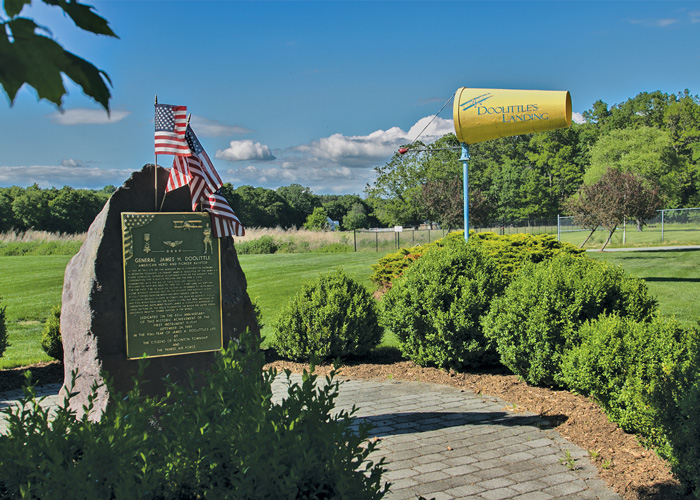
The breakthrough revolutionized aviation efficiency and changed the world. While World War II hero Jimmy Doolittle piloted the official first blind flight at Mitchel Field in Garden City Long Island, the legwork happened at the Aerodrome, where Doolittle was said to be a regular. Along the trail stands a bonus for children, “Doolittle’s Landing,” a playground adjacent to a historic marker that explains the achievements of its legendary namesake.
If you could put a canoe in at Beaver Brook, steps from the Flight Path Trail, you could paddle your way from the Aerodrome to another historic airport, Lincoln Park Airport. But with no public access to the brook, an eight-mile drive through mostly rural territory has to do.
On your way, around the bend from the Pyramid Mountain county park on Boonton Avenue, you’ll pass Marotta Controls, founded by another pioneer, Patrick T. Marotta, whose development of fuel control valve advanced rocket and missile science. For more than half a century, the family-owned company supplied NASA and the U.S. military with high-pressure valves and other components for high profile spacecraft including Gemini, Saturn, Apollo, the Lunar Module, and the Space Shuttle.
Make your way past the Taylortown Reservoir and Surprise Lake and over the rise to Lincoln Park Airport. Legendary pilot Amelia Earhart’s mechanic, Ed Gorsky, with his wife Julia, purchased the property long after Earhart had disappeared and declared first missing, then dead. They built the airport on what was then a celery field.
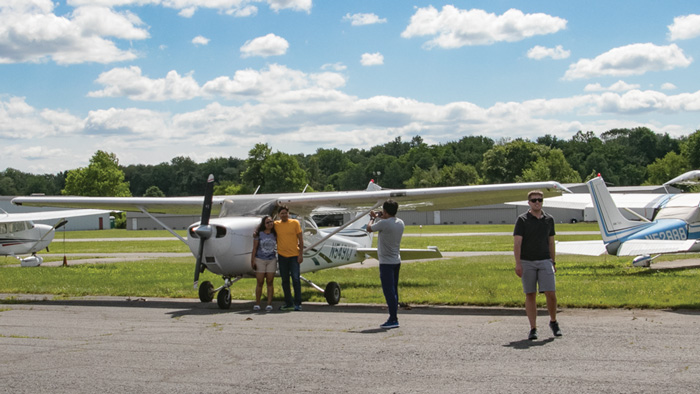
Today, the airport offers ten-minute helicopter tours through Garden State Helicopters, flying lessons through Aero Safety Training and plenty of aviation atmosphere at the Sunset Pub & Grille. Patrons can sit outdoors, just feet from the runway and watch all the action: planes arriving and leaving and undergoing checks and maintenance, with the distant Ramapo Mountains as a higher altitude backdrop. An octagonal upstairs room with runway views begs for a theme party.
Charles Fletcher, a former navy pilot and inventor ended up taking tech beyond the Boonton/Montville/Denville research triangle, into Sussex County, opening his own company, Technology General Corporation in Franklin, and experimenting with a novel floating craft in Sparta. While a project engineer at Reaction Motors of Denville, he had worked on the development the X-15 “spaceplane,” engine. The X-15, a workhorse in the early days of manned space flight, was designed to enter space with tremendous thrust from a much larger sub-orbital carrier airplane.
But prior to the X-15, Fletcher had been working another aero-tech angle: a “floating” transport vehicle. Although a British scientist claimed to be the originator, Fletcher asserted he was first, having designed it in secret while serving in the U.S. Navy (military status prevented him from patenting it). A Sparta resident, he named his invention the “Glide Mobile,” testing it in 1959, on a local pond. Today, hovercrafts move on an air cushion across water, mud and impassable terrain, often transporting military equipment and personnel and rescuing those trapped in disaster zones, where ordinary trucks or boats can’t navigate.
Nearby Fletcher’s Sparta hovercraft test zone, the Sussex Airport, former home of the renown Sussex Airshow until the operation's former owner was charged with embezzlement, has been revived by new managment, offering parking, tie downs, and fuel services for public use.
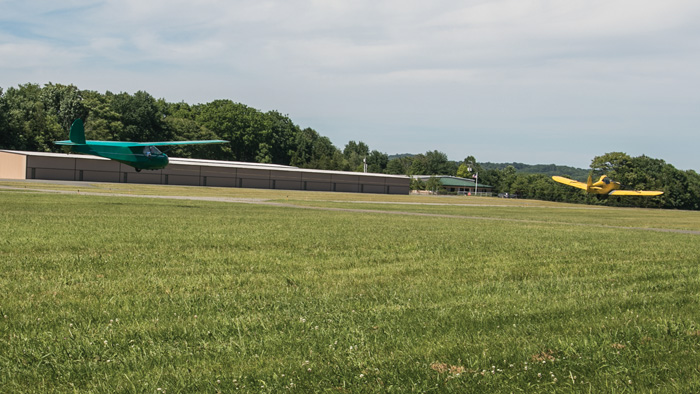
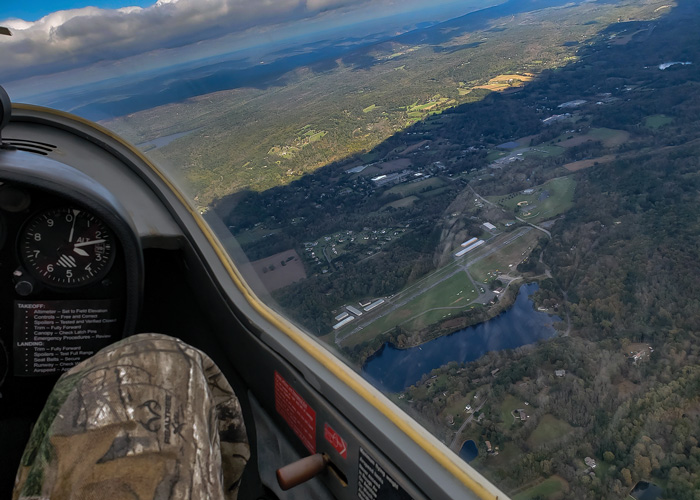
One county over, at the Blairstown Airport, gliding beckons the adventurous. At Jersey Ridge Soaring, couples or solo passengers lift up and over the Delaware Water Gap and surrounding Kittatinny Mountains, often seeking to spot and photograph their homes below. While open year round, summer reigns as gliding high season. Scary? Maybe a little — but spectacular. As one of the owners, Brenda Martin, says, “it’s a trust thing.” Plus, all flights have commercial pilots at the helm.
The scenery and scale change as you approach Morristown Airport to the south, which spreads out on 600 acres near the tangle of busy highways and one of country’s busiest aviation corridors. Here corporate and private jets come and go 24 hours a day, ferrying executives to meetings and conferences and elite travelers wherever their hearts desire. The airport, owned by the municipality but operated by a private company, hosts thousands of passengers a year.
“We have customs and border protection (for a fee)” explains Darren Large, director of facilities and operations. “It’s an access point for Northwest New Jersey and the world.”
Private charter and privately owned jets regularly fly in and out of Morristown, with owners and passengers strolling to their planes from the private terminal, escaping, at a price, such commercial airline irritants as long security lines, luggage restrictions, and cramped seating.
Those with very deep pockets and in the mood for a splurge can hire a medium sized private jet (capacity of up to eight passengers) through Private Fly, a charter company that flies out of the airport. Depending on the date, a one-way flight from Morristown to Las Vegas in a Lear Jet or Cessna should run a couple about $27,000. Add six people, and the per person price descends, with the total coast at a little more than $31,000 for that four to five hour fun flight.
Of course, a quick glimpse of that lifestyle can be had for much less with a custom (at no charge) tour of the airport. Let the guide know your interests when you book online. Then schedule and spend one to two hours viewing the private terminal and checking out the aircraft, hangars, and equipment (“snow fleet” and fire fighting) on the grounds.
Whatever the headaches and threats to their existence, Skylands flight stalwarts and airports carry on, highlighting aviation history, entertaining and informing flight fans and families, not to mention luring spectators to adventurous experiences aloft. This summer, they’ll continue to reward those drawn to the skies, which have been beckoning humans for centuries.